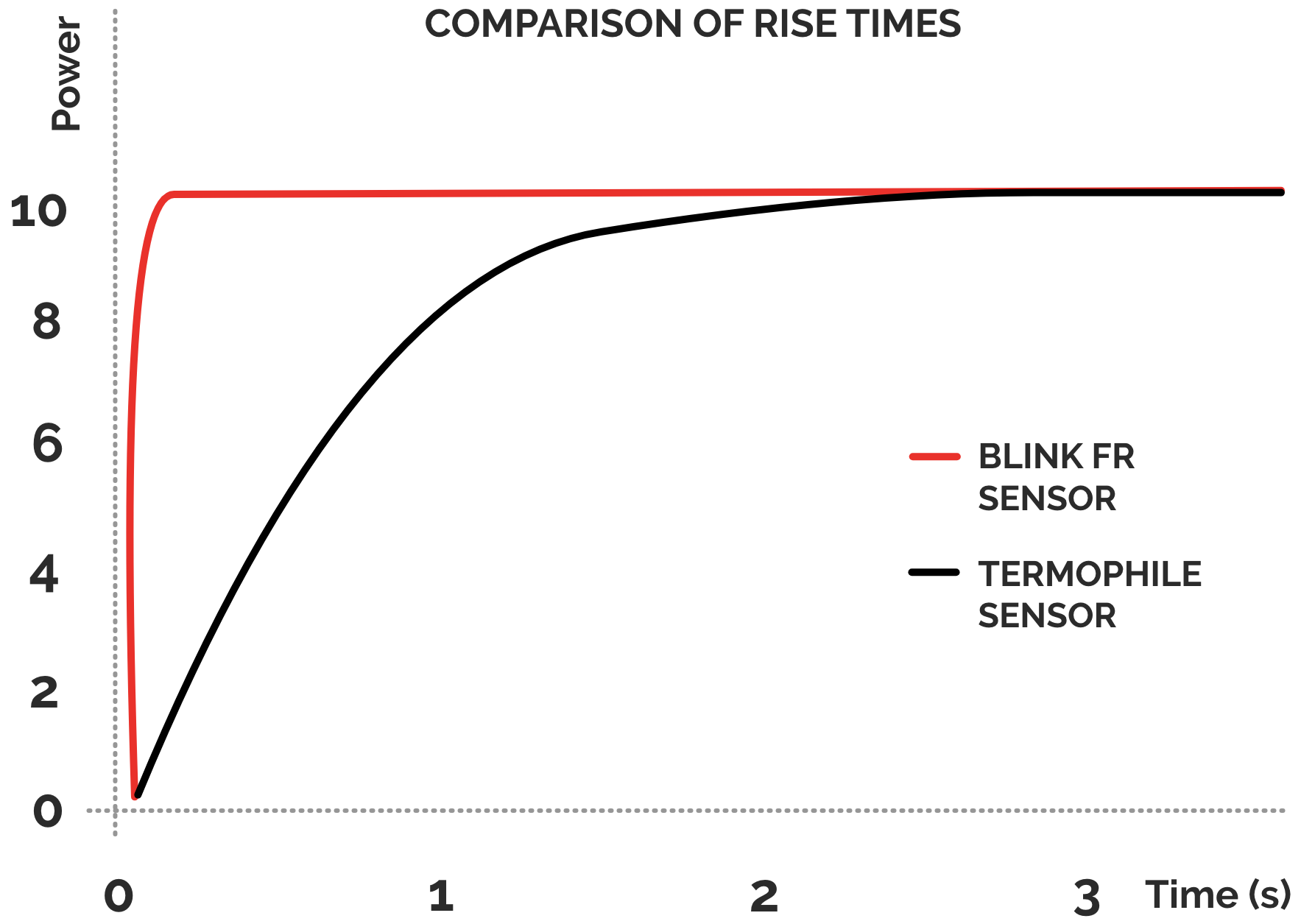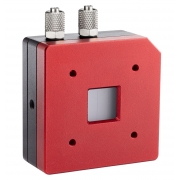Blink-FR: fast response laser power sensor head: 90ms
LaserPoint's BLINK-FR laser sensors are based on a proprietary technology which enables natural response times of 90 ms (typ.) while still keeping broadband spectral range, power density capability and direct high power operation up to 50W.
The response time is a key parameter for laser detectors where a fast measurement is required. Several phenomena like pointing stability, fast drifts, instabilities, etc,… can only be monitored if the detector responds very quickly. However, when the detector is fast it cannot withstand high powers and when it measures high power it is slow:
- photodetectors can respond to pulses < 1ns but can only withstand milliwatts of direct laser power.
- thermopile detectors are inherently slow: their natural response times range from > 1s to several tens of seconds, depending on the maximum power rating. Those response times can be reduced by electronics and speed-up algorithms, but cannot be lower than 800ms-1 s, and only in the case of very low power heads.
Blink-FR fast response laser power sensor heads solve the problem, offering
- response time down to 90 ms (typ.) (without any acceleration by additional electronics)
- 50W measuring power.
- measurement active area: 16x16 mm
These new laser power measurement sensors open the way to a number of applications that were not possible before.

Chart of models: fast response laser power and energy sensor meter Blink-FR
| Power Mode | LPT-BL-A-5W-16-K | LPT-BL-A-8W-16-K | LPT-BL-A-25W-16-K | LPT-BL-W-50W-16-K |
| Power range | 25 mW - 5 W (0) | 25 mW - 8 W (0) | 25 mW - 25 W | 30 mW - 50 W |
| NEP | 1 mW | 1 mW | 1 mW | 15 mW |
| Response time (0-90%) | Typ. 90 ms (50-120ms) |
| Power calibration uncertainty | +/-3% |
| Power linearity (1) | +/-3% | +/-3% | +/-3% | ± 5% |
| Spatial uniformity (2) | +/-3% |
| Energy Mode | | | | |
| Energy range | 20 mJ - 5 J |
| Max repetition rate | 5 Hz |
| Calibration Uncertainty | ± 5% |
| Absorber Specs | | | | |
| Aperture | 16 x 16 mm |
| Absorber Spectral Range | 0.2 - 25 µm |
| Calibration Spectral Range | 0.25 - 1.1 µm; 10.6 µm |
| Max. Power Density (3) | 1,5 KW/cm2 |
| Max. Energy Density | 1 J/cm2 (10 ns pulse) |
| General Characteristics | | | | |
| Cooling | Convection | Convection | Forced air (a) | Water (b) |
| Weight | 140 g | 240 g | 380 g | 130 g |
| Dimensions | 60x60x16.1 mm | 60x60x41.2 mm | 60x60x66 mm | 56x56x18,5 mm |
Notes:
(0) 25W max 2 sec exposure, max 20% duty cycle
(1) Detector centrally irradiated @50% of useful surface.
(2) 3mm beam diameter, scanning 80% of active area
(3) Measured at 1064 nm, 2W (convection) / 5 W (forced air) / 10W (water). Damage thresholds depend on power level.
(a) Recommended ambient temperature: 10 -35 °C
(b) Water Min. 1 l/min, Max 4 l/min (@ 10-25 °C). Admissible rate of water temperature variation < 1 °C/min.
The Blink-FR laser sensors LPT-BL are available either with
- USB connection
- RS232 connection
- connection to external power and energy meter LPT-PLUS-2
Also available as OEM amplified sensor with connection through bare wires
Meet here all our laser power and energy sensors, splitted into their two main groups:
- standard laser power and energy sensors-meters
- BLINK: high speed laser sensors, for ultrafast lasers (picoseconds, femtoseconds).
If you work with lasers, visit our sections:
- laser power and energy measurement (standard thermopile and photodiode sensors and meters
- laser safety and protection
- laser beam profile analyzers





